Chess no. 432
PHILIDOR
T. S. Krishnamurthy and C. G. S. Narayanan (The Problernist, September 1968). White to play and mate in two moves; solution next week. Solution to no. 431 (Monreal and Boyer): Q – Q 6, threat R x R. 1 . . . B – K 5; 2 R – Q B 5. 1 . . . R – K 5; 2 Kt – Q 3. 1 . . . P – Kt 5; 2 B – R 6. Curious problem, with the White pieces doing their job effectively despite the pins.
The following game was played in the 1968 tournament at Palma de Majorca where Korch- noi's brilliant victory confirmed his current position of the finest tournament player in She world. His opponent, Diez del Corral, in this game is a very dangerous attacking player with a num- ber of fine wins to his credit; it is all the more striking to see how Korchnoi, with Black, out- combines him in the kind of position that suits Corral's style.
White. Diez del Corral. Black, Korchnoi. Opening. Sicilian. (Palma de Majorca, 1968.) 1 P–K 4 P–QB4 2 Kt–KB3 Kt–QB3 3P–Q4• Px P 4 Kt xP P–K 3 5 Kt x Kt . . . I can't really believe in this move; it gives Black too strong a central position.
KtP X Kt 6 B – Q 3 Kt – B 3 7 0– 0 . . . 7 P–K5??, Q–R 4 ch 7... P–Q3 7...P–Q 4; 8P–Ki
will give White some attacking chances.
8 P–Q Kt 3 B – K 2 9 B – Kt 2 P – K 4
10 Kt – Q 2 0 – 0 11 Kt – B 4 B – K 3
12 Q – K 2 . . . It is difficult to find a way for White to make much of the position: his only positive line is 12 P – B 4 which (after 12 . . . P x P) leaves a strong square on K 4 for the Black knight. Nevertheless, I would be inclined to try this (probabb wrongly!).
12 . . . Kt-Q2 13 QR-Q1 R-K 1
14 Q - Q 2 Kt - B4 15 K R-K I P - B 3! Consolidating the centre and preparing a cen- tral advance.
16 Kt-R5 Q-B2 17 B-B4 B x B 18 Kt X B Kt x P With this move Black begins to take the initiative.
19 R X Kt P - Q 4 20 R - Kt 4 P x Kt
21 Q-R 6? . . . Misjudging the position; he should play 21 R X P. after which the position is about equal, Black's open files and better centre compensating for his broken pawns.
21 . . B - B 4! And not 21 . P-1(13?; 22 R X P ch. P x R; 23 Q X P ch and now after 23 . . K - R 1 White can draw by perpetual check, while 23 . . . K - B 1; 24 B - B 1! exposes Black to a very dangerous attack.
22 QxBP P x P 23 RPxP R -K 2! Threatening 24 ...QR-K B I.
24 Q-Kt 5 R-KB1 25 R-K B I Q-Q 2! Threatening 26 . . . R X P.
26 R - Q B 4 . . . There is no defence; e.g.
26 P - Kt 3. B x P ch; 27 R X B, Q - Q 8 ch: 28 K - Kt 2. R X R ch; 29 K x R, R - B 2 ch and White must play 30 R - B 4 to avoid mate-or 26 P - K R 3, R X P; 27R x R, Q - Q 8 ch; 28 K - R 2, B X R and mate follows.
26 . . . B x Pch! 27 K- R 1 R(2)-B2 Threatening 28 . . . B - K 6.
28 Q - R 5 Q - Q 7 29 R x P A last trap in a lost position.
29 . . B - Kt 3! Not 29 . . . B - Q 5?;
30 Q X Rcltl,R X Q; 31 R - B 8 ch and mates. After 29 . . . B - Kt 3 this does not work-30 Q x R ch. R x Q; 31 R- B 8 ch,
B - Q 1!: now White has no defence to the threat of 30 . . R x R ch (of course 30 R x R is met by 30. . . Q - K 8 ch) so, 30 Resigns.



































 Previous page
Previous page